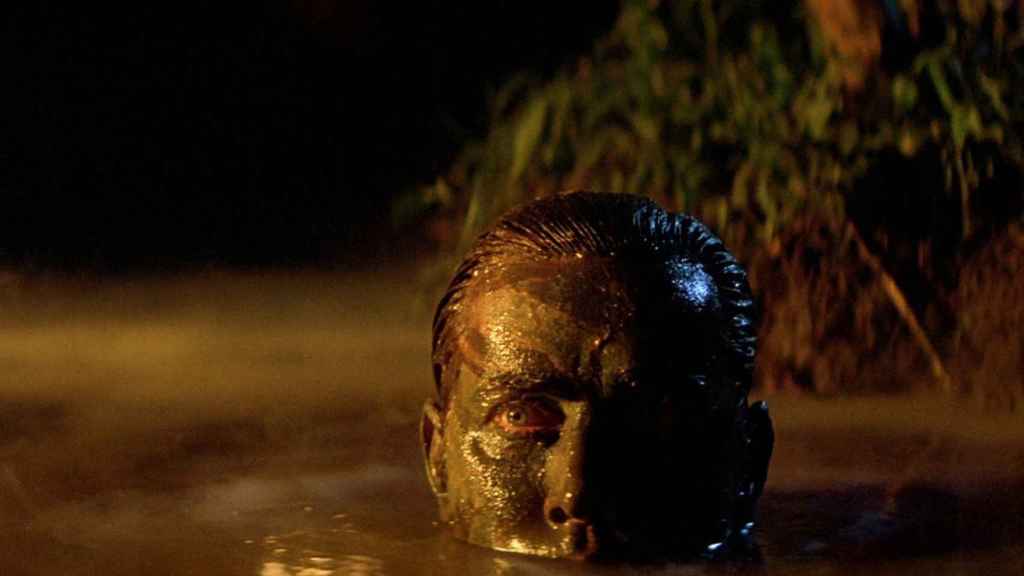This comparative film analysis essay reflects on the audiovisual ways the film “Apocalypse Now” converges and diverges from the source material it is adapted from (“The Heart of Darkness”) in its exploration of themes related to postcolonialism; race, masculinity, violence, domination…

Apocalypse Now Reflection
Apocalypse Now, Francis Ford Coppola’s film adaptation of Conrad’s novel Heart of Darkness, tells the story of Captain Willard on a journey, through the Srepok River, and mission to terminate Colonel Kurtz. From this premise, we can see the first differences from the book to screen translation. The setting changes from the 19th Century British ivory trading companies in Africa to the Vietnam war –or the Resistance War Against America, depending on which side is it looked from– that took place in the Cambodia, Vietnam and Laos territories from 1955 to 1975, with US involvement until 1973 to support South Vietnam in its anti-communism attempt.
Released four years after the end of the war, in 1979, Apocalypse Now is an updated version of Conrad’s story; a way to bring back the debate of “the horror” of war that repeats throughout history due to the “evil” or “madness” that lies within mankind. Staying true to this moral essence, Coppola kept the social commentary and denounce of war as a background for character development, casting the spotlight –or magnifying glass– on the protagonist, Captain Willard, just as Conrad did with Marlow. This inductive approach allows a more complex and deep understanding of the nature of human violence, as we see it incarnated and evolving in front of our sight throughout elements of the plot and the form.
After the opening images –helicopters and explosions– that establish the tone of the film and the conflict that it is based on, we get introduced to the protagonist going through a PTSD episode in his hotel room accompanied by loud rock music (The End by The Doors). The rock-n-roll background music is used throughout more than the first half of the film to illustrate the recklessness of men –especially the youngest– in war. The scene when Willard’s crew and Kilgore are on their way to the surf spot is an exception, where Coppola chose a classic song (Wagner: Die Walküre / Dritter Aufzug – “Hojotoho! Heiaha!”) to play with –and probably mock– the solemnity associated with the war affairs and the “feat” the characters feel they are in. All this loudness, brightness and grandiosity contrasts with the third act of the movie, that becomes silent, dismal and unforeseeable, as the remaining crew approaches Kurtz and the heart of the jungle. This shift of the ambient sounds and imagery represents an internal shift on the protagonist and happens right after Willard kills –for the first time– a girl that was severely wounded by an accidental conflict caused by one of his crew members. The silence and fear created by Willard in this scene, where he reveals his true self (every time more like Kurtz), becomes a consistency. At this point, Willard’s drive to get to Kurtz guides his actions over any moral compass he previously had; what started as a simple curiosity about his mission’s target became an obsession with the man he identifies with and the feeling he describes as “much stronger than fear, was the desire to confront him”.

The voice over resource used by Coppola is effective, not only because Willard’s mission is confidential and therefore something he can’t discuss with others, but because it lets the audience into Willard’s mind just as Marlow narrated his deeply personal experiences. We learn about Kurtz as Willard does, through his resume and archive documentation, narrated by Willard’s internal voice (voice over), which also lets us into the progression of his thoughts and feelings about Kurtz in a multi-layered narrative.
Even though the focus is on Willard’s experience, just as in Heart of Darkness, Apocalypse Now uses different characters to personify relevant values of the time, perspectives or themes of the story; Kilgore as the spectacularization of war and American whims, the Chef to portray the fragile masculinity (in the tiger scene), or the photo-journalist (equivalent to the Russian Trader in the novel) that represents the fanatism and blind faith in figures of authority, like a prophet or a politician.
Although Apocalypse Now manages to give voice to a diverse kind of men, it fails to update in the uni-lateral and repressive discourse of power –both in terms of gender and race– presented by Conrad’s Heart of Darkness, perpetuating the racism and sexism it tries to denounce; the women that knitted and prayed for men going to war in Conrad’s piece are the women that dance to entertain men and have sex with them in Apocalypse Now. A contemporary adaptation, in today’s socio-political climate, would surely have to re-think and fix these issues. What would be the Heart of Darkness of our times, the Apocalypse Now of the last decade? Who would tell it and how?
REFERENCES
Conrad, Joseph. Heart of Darkness. The Project Gutenberg (EBook #219), 2009, https://www.gutenberg.org/files/219/219-h/219-h.htm.
Apocalypse Now. Directed by Francis Ford Coppola, performances by Martin Sheen, Marlon Brando, and Robert Duvall, redux version, Zeotrope Studios, 1979.